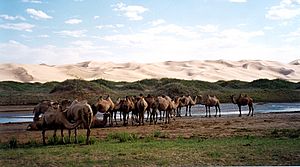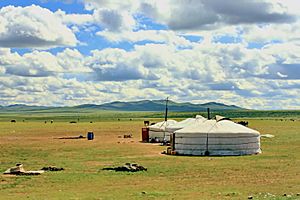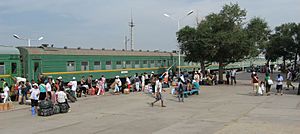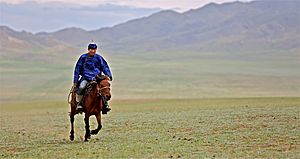Mongolia facts for kids
Quick facts for kids
Mongolia
|
|
|---|---|
|
|
|
|
Anthem: Монгол улсын төрийн дуулал
Mongol ulsyn töriin duulal "National Anthem of Mongolia" |
|
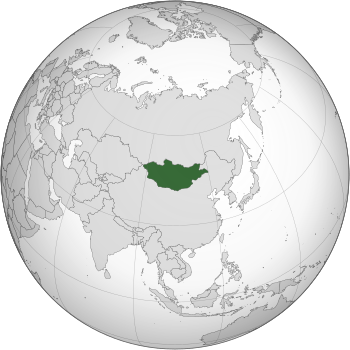 |
|
| Capital and largest city
|
Ulaanbaatar |
| Official languages | Mongolian |
| Official scripts |
|
| Ethnic groups
(2020)
|
|
| Religion
(2020)
|
|
| Demonym(s) | Mongolian, Mongol |
| Government | Unitary semi-presidential republic |
| Ukhnaagiin Khürelsükh | |
| Luvsannamsrain Oyun-Erdene | |
| Legislature | State Great Khural |
| Formation | |
| 209 BC | |
| 1206 | |
|
• Completion of Qing dynasty conquest
|
1691 |
|
• Declaration of independence from the Qing dynasty
|
29 December 1911 |
|
• Mongolian People's Republic established
|
26 November 1924 |
|
• Current constitution
|
13 February 1992 |
| Area | |
|
• Total
|
1,564,116 km2 (603,909 sq mi) (18th) |
|
• Water (%)
|
0.67 |
| Population | |
|
• 2020 estimate
|
3,227,863 (134th) |
|
• Density
|
2.07/km2 (5.4/sq mi) |
| GDP (PPP) | 2023 estimate |
|
• Total
|
|
|
• Per capita
|
|
| GDP (nominal) | 2023 estimate |
|
• Total
|
|
|
• Per capita
|
|
| Gini (2018) | 32.7 medium |
| HDI (2021) | high · 96th |
| Currency | Tögrög (MNT) |
| Time zone | UTC+7/+8 |
| Date format | yyyy.mm.dd (CE) |
| Driving side | right |
| Calling code | +976 |
| ISO 3166 code | MN |
| Internet TLD | .mn, .мон |
Mongolia is a landlocked country in East Asia and Central Asia. It borders Russia to the north and the People's Republic of China to the south, east and west. Mongolia's political system is a parliamentary republic.
Until recently, most of the people there were Buddhists. Many of them are nomads (people who always move from place to place and do not stay in one home), but this is changing. The largest city, and capital city is Ulaanbaatar. It is where about 38% of the population live. This has been spelled Ulan Bator/ Ulaan Battor and other ways in the past. The north and east parts of the country have many mountains. Part of the south part is the Gobi Desert. There are 2,791,272 people living in Mongolia. The country is the 18th biggest country in the world, with an area of 1,564,116 km2 (603,909 sq mi).
Mongolia is mainly rural with the lowest population density of all independent countries in the world.
Contents
History
The area which is Mongolia has been ruled by various nomadic empires. This was until the great 'Mongol Empire' was founded by Genghis Khan in 1206. After the Yuan Dynasty collapsed, the Mongols became nomads again. After the 16th century, Mongolia were influenced by Tibetan Buddhism. By the end of the 17th century, most of Mongolia was part of an area ruled by the Qing Dynasty. When the Qing Dynasty collapsed in 1911, Mongolia declared independence. But they had to fight against the Chinese. They were helped by the Soviet Union. In 1921, the world accepted its independence. Shortly after the death of Bogd Khaan, the last monarch of Mongolia the monarchy was replaced by a communist government in 1924, and the country was renamed the Mongolian People's Republic. Up until the fall of the Soviet Union, Mongolia was a satellite state for the Soviets. The Mongolian Red Cross Society was set up in 1939. It has its headquarters in Ulaanbaator. Following the break-up of the Soviet Union in 1991, Russia's interest in Mongolia has declined. China and South Korea are currently Mongolia's main trade and political partners.
Government
Mongolia is a parliamentary republic. People vote for their government. The President of Mongolia is elected to a four-year term, and cannot be elected president more than twice. The current President is Khaltmaagiin Battulga. He was first elected as president on July 7, 2017.
Climate
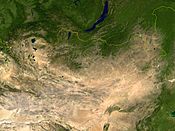
Mongolia has a steppe climate. It has very cold winters and mild summers. Recently, winters have become very cold. This has killed many people and cattle. On June 2, 2008, 52 people and 200,000 head of cattle died in heavy blizzards in Mongolia.
On March 1–2, 2008, a heavy dust storm hit northeast China and parts of Mongolia. and ended over North Korea and South Korea on the March 4.
Twenty one people died in a rural Mongolian blizzard on May 8, 2008. Parts of the Chinese province of Inner Mongolia were also affected on the May 8, 2008.
On June 2, 2009, it was said that 15 people and 10,000 head of cattle had died by this date in Mongolia.
April 1–2, 2010 had temperatures plummet to -50 degrees in Mongolia’s Tuul valley, A nomad named Urna said she bought 400 bundles of grass to feed the animals in preparation for more bad weather. The Mongolian Red Cross has said that about 4,500,000 livestock died as a result of the bad weather this year [2010]. Tume, who lives in Ulan Bator, said that he had noticed that there were several really harsh winters in a row too. He blamed climate change, but experts said that overgrazing by cattle had also killed off most of the country’s grassland.
Mongolia known as the "Land of the Eternal Blue Sky" or "Country of Blue Sky" (Mongolian: Mönkh khökh tengeriin oron - Мөнх хөх тэнгэрийн орон) because it has over 250 sunny days a year.
Geography
Mongolia is the world's 19th-largest country (after Iran). It is significantly larger than the next-largest country, Peru. Mongolia does not share a border with Kazakhstan, but its westernmost point is only 38 kilometers (24 mi) away from Kazakhstan.
The geography of Mongolia is varied, with the Gobi Desert to the south and with cold and mountainous regions to the north and west. Most of Mongolia consists of steppes, with forested areas comprising 11.2% of the total land area. The highest point in Mongolia is the Khüiten Peak in the Tavan bogd massif, at a height of 4,374 m (14,350 ft).
Wildlife
The name "Gobi" is a Mongol term for a desert steppe, which usually refers to a category of arid rangeland with insufficient vegetation to support marmots but with enough to support camels. Mongols distinguish Gobi from desert proper, although the distinction is not always apparent to outsiders unfamiliar with the Mongolian landscape.
Gobi rangelands are fragile and easily destroyed by overgrazing, which results in expansion of the true desert, a stony waste where not even Bactrian camels can survive. The arid conditions in the Gobi are attributed to the rain shadow effect caused by the Himalayas. Before the Himalayas were formed by the collision of the Indo-Australian plate with the Eurasian plate 10 million years ago, Mongolia was a flourishing habitat for major fauna but still somewhat arid and cold due to distance from sources of evaporation. Sea turtle and mollusk fossils have been found in the Gobi, apart from well-known dinosaur fossils. Tadpole shrimps are still found in the Gobi today. The eastern part of Mongolia including the Onon and Kherlen rivers and Lake Buir form part of the Amur river basin draining to the Pacific Ocean. It hosts some unique species like the Eastern brook lamprey, Daurian crayfish (cambaroides dauricus) and Daurian pearl oyster (dahurinaia dahurica) in the Onon/Kherlen rivers as well as Siberian prawn (exopalaemon modestus) in Lake Buir.
Mongolia had a 2019 Forest Landscape Integrity Index mean score of 9.36/10, ranking it sixth globally out of 172 countries.
Provinces
Mongolia is divided into 21 provinces called aimags. The aimags are divided into 329 districts called sums.
- Arkhangai
- Bayan-Ölgii
- Bayankhongor
- Bulgan
- Darkhan-Uul
- Dornod
- Dornogovi
- Dundgovi
- Govi-Altai
- Govisümber
- Khentii
- Khovd
- Khövsgöl
- Ömnögovi
- Orkhon
- Övörkhangai
- Selenge
- Sükhbaatar
- Töv
- Uvs
- Zavkhan
Languages
The official language of Mongolia is Mongolian, and is spoken by 95% of the population. A variety of dialects of Oirat and Buryatare are spoken across the country. Turkic languages, such as Kazakh and Tuvan, are also spoken in the western part of the country.
Today, Mongolian is written using the Cyrillic alphabet, although in the past it was written using the Mongolian script. The traditional alphabet is being slowly reintroduced through schools recently.
Russian is the most frequently spoken foreign language in Mongolia due to their diplomatic ties as former communist states. However, English has been gradually replacing Russian as the second language in order to become part of the world economy. Korean has gained popularity as tens of thousands of Mongolians work and study in South Korea. Interest in Chinese has been growing because of the neighboring power.
Transportation
The Trans-Mongolian Railway is the main rail link between Mongolia and its neighbors. It begins at the Trans-Siberian Railway in Russia at the town of Ulan-Ude, crosses into Mongolia, runs through Ulaanbaatar, then passes into China at Erenhot where it joins the Chinese railway system. A separate railroad link connects the eastern city of Choibalsan with the Trans-Siberian Railway. However, that link is closed to passengers after the Mongolian town of Chuluunkhoroot. Mongolia also has a 233 km-long cargo rail link from the Tavan Tolgoi coal mine to Chinese border.
Mongolia has a number of domestic airports, with some of them having international status. However, the main international airport is Chinggis Khaan International Airport, located approximately 52 km (32 mi) south of the capital Ulaanbaatar. Direct flight connections exist between Mongolia and South Korea, China, Thailand, Hong Kong, Japan, Russia, Germany, and Turkey. MIAT Mongolian Airlines is Mongolia's national air carrier, operating international flights, while air carriers such as Aero Mongolia and Hunnu Airlines serve domestic and short international routes.
Many overland roads in Mongolia are only gravel roads or simple cross-country tracks. There are paved roads from Ulaanbaatar to the Russian and Chinese borders, from Ulaanbaatar east- and westward (the so-called Millennium Road), and from Darkhan to Bulgan. A number of road construction projects are currently underway. Mongolia has 4,800 km (3,000 mi) of paved roads, with 1,800 km (1,100 mi) of that total completed in 2013 alone.
National Holidays
| Date | Holiday |
|---|---|
| January 1 | New Year |
| January Or February | Old new year (Tsagaan sar) |
| March 8 | International Woman's Day |
| June 1 | Children's day |
| July 11–15 | Naadam Holiday |
| December 29 | Independence day |
Related pages
Images for kids
-
Mongol Empire expansion (1206 till 1294)
-
This map shows the boundary of the 13th-century Mongol Empire compared to today's Mongols. The red area shows where the majority of Mongolian speakers reside today.
-
Altan Khan (1507–1582) founded the city of Hohhot, helped introduce Buddhism and originated the title of Dalai Lama
-
Mongolian troops fight against the Japanese counterattack at Khalkhin Gol, 1939
-
Mongolian Premier Yumjaagiin Tsedenbal was the longest-serving leader in the Soviet Bloc, with over 44 years in office
-
The southern portion of Mongolia is taken up by the Gobi Desert, while the northern and western portions are mountainous.
-
Ulaanbaatar is the capital and largest city of Mongolia
-
A ger in front of the Gurvan Saikhan Mountains
See also
 In Spanish: Mongolia para niños
In Spanish: Mongolia para niños




